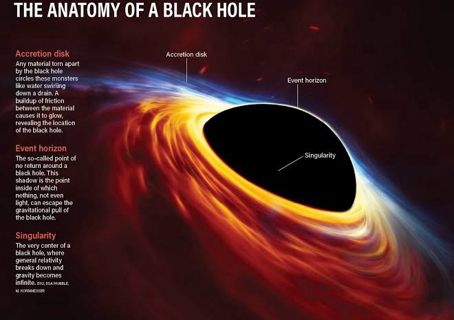
Black Hole Explanation
A black hole is a region in space where the gravitational pull is so strong that nothing, not even light, can escape it. The force of gravity is determined by the mass of the object and the distance from it. In the case of black holes, the mass is concentrated in a small region, known as the singularity, which creates an extremely strong gravitational field.
Black holes come in three main types:
1. Stellar black holes: formed from the collapse of massive stars
2. Intermediate black holes: found in the centers of galaxies and thought to play a role in their evolution
3. Supermassive black holes: found at the centers of most galaxies, including our own Milky Way, and thought to play a key role in regulating the growth and behavior of galaxies.
There are several ways to detect black holes, including observing the motion of nearby stars and gas, and searching for X-ray emissions from material falling into the black hole.
The study of black holes has led to a greater understanding of the laws of gravity and their role in the universe.
Stellar black holes:-
Stellar black holes are black holes formed by the collapse of a massive star. They are relatively small compared to supermassive black holes, with masses ranging from a few to tens of times that of the sun. They are typically found in binary star systems or in isolated regions of space, and are often detected through the observation of X-rays or gravitational waves.
Stellar Black Hole Overview
Stellar black hole Formation
Stellar black holes are black holes that are formed from the collapse of a massive star.
Formation: When a massive star reaches the end of its life, it can no longer generate enough energy to counteract the pull of gravity. This results in the star collapsing inward and forming a black hole.
Size: Stellar black holes are relatively small, with masses ranging from about 3 to 20 times that of the sun.
Location: Stellar black holes are found throughout our galaxy and are typically located in binary star systems or in the centers of globular clusters.
Detection: Stellar black holes can be detected through their effects on nearby objects, such as stars that they are in orbit around. The motion of the nearby star can reveal the presence of the black hole.
Significance: Studying stellar black holes provides valuable information about the evolution of stars and the formation of black holes, which in turn can give us insights into the structure and evolution of our universe.
Future research: Future research will likely focus on identifying and studying more stellar black holes, as well as understanding their properties and behavior in greater detail.
Intermediate black holes
Intermediate black holes are black holes with masses between those of stellar black holes (typically around 5 to 30 solar masses) and supermassive black holes (millions to billions of solar masses). They are believed to play a key role in the formation and evolution of galaxies. However, their existence has not yet been firmly established and more evidence is needed for their confirmation.
Intermediate black holes are celestial objects with mass ranging from a few hundred to tens of thousands of solar masses. Unlike supermassive black holes that reside in the centers of galaxies and have millions or billions of solar masses, intermediate black holes are thought to form from the merging of smaller black holes or from the collapse of massive stars.
These black holes can have a profound effect on their surroundings and have been proposed as the engine behind certain types of astronomical phenomena, such as luminous X-ray sources, gamma-ray bursts, and active galactic nuclei.
Due to their elusive nature, intermediate black holes have proven difficult to detect and study. Astronomers use a variety of observational techniques, including X-ray and radio observations, to search for evidence of these objects and to better understand their properties and behavior.
Despite the ongoing research, much remains unknown about intermediate black holes and their role in the universe. Further studies and observations will be needed to shed light on these fascinating celestial objects.
Intermediate Black Hole Formation
Intermediate-mass black holes (IMBHs) are believed to form through a variety of mechanisms, including:
Direct collapse: IMBHs can form from the direct collapse of massive clouds of gas and dust.
Mergers: IMBHs can also form from the merging of smaller black holes in dense star clusters.
Runaway collisions: In dense star clusters, massive stars can collide and merge, eventually forming an IMBH.
Accretion: An IMBH can also form from the gradual accretion of matter onto a smaller black hole.
It is still not yet fully understood how IMBHs form, and more research is needed to confirm these theories and understand the process better.
Follow Nikhil Kumar to stay updated on their latest posts!
0 comments
Be the first to comment!
This post is waiting for your feedback.
Share your thoughts and join the conversation.
